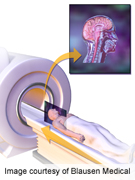
TUESDAY, March 6 (HealthDay News) — Most stroke patients undergo both CT and MRI brain scans, an unnecessary duplication that contributes to the rising costs of stroke care in the United States, a new study indicates.
University of Michigan researchers analyzed data from more than 600,000 patients diagnosed with stroke between 1999 and 2008 in 11 states, and found that 95 percent of the patients who had MRI scans also had CT brain scans.
“Compared to CT, MRI is a more accurate test for stroke. But our results showed that MRI is not replacing CT as the primary stroke neuroimaging study — instead, patients are getting both,” study author Dr. James Burke, a clinical lecturer in the medical school’s neurology department, said in a university news release.
“Minimizing the use of multiple studies could be a viable strategy to reduce costs,” he added.
The researchers noted that the costs of inpatient stroke care rose 42 percent between 1997 and 2007, an increase of $3,800 per stroke case. Brain scans were the largest contributor to the increased costs, they found.
“The data shows that neuroimaging practices in stroke are neither standardized [nor] efficient,” Burke said. “This represents an area where we have an opportunity to substantially reduce the cost of care without adversely affecting the quality of care.”
The study was published in the February issue of the Annals of Neurology.
“The issue of duplicative imaging in stroke is just one example of wasteful care,” journal editors Dr. S. Clairborne Johnson and Dr. Stephen Hauser wrote in an accompanying editorial.
More information
The U.S. National Institute of Neurological Disorders and Stroke has more about stroke.

